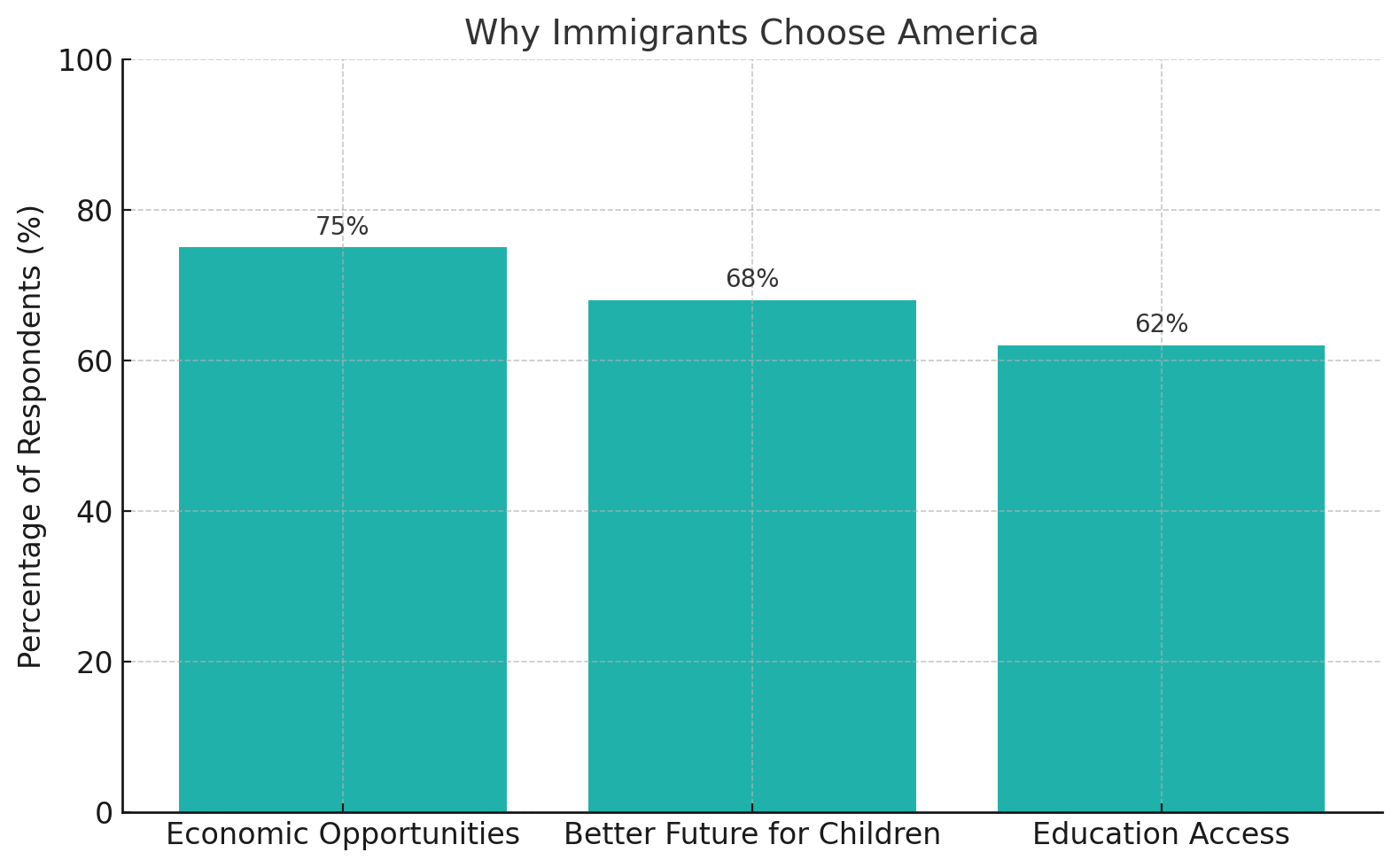Understanding Immigration in America

Why America?
Why would someone leave their home, risk everything, and cross borders for a chance at America?
In 2021, more people around the world said they wanted to move to the United States than any other country1. As of 2024, the U.S. is home to more than 50.6 million immigrants, far surpassing any other nation2. The reasons aren’t always political or even economic, they’re deeply human.
The answer lies in what America represents to millions.
A 2023 survey by the Kaiser Family Foundation and Los Angeles Times revealed what drives this dream:
Understanding Immigration in America

Chart of why immigrants choose America.
Why America?
Why would someone leave their home, risk everything, and cross borders for a chance at America?
In 2021, more people around the world said they wanted to move to the United States than any other country1. As of 2024, the U.S. is home to more than 50.6 million immigrants, far surpassing any other nation2. The reasons aren’t always political or even economic, they’re deeply human.
The answer lies in what America represents to millions.
A 2023 survey by the Kaiser Family Foundation and Los Angeles Times revealed what drives this dream:
- 75% sought better economic opportunities
- 68% wanted a better future for their children
- 62% aimed for access to quality education
- Others were drawn by America’s civil liberties, safety, and freedom of expression3
These are not abstract ideals. They are promises people are willing to uproot their entire lives for, whether they arrive through legal pathways or not.
What It Means to Be an Immigrant
Roughly 1 in 10 Americans today is a naturalized citizen, a first generation immigrant who took the long, winding road to call this country home. These are teachers, engineers, nurses, small business owners, soldiers, and parents. They’ve studied for citizenship exams, paid taxes, learned a new culture, and built lives with purpose and sacrifice.
For both legal immigrants and those without status, the journey demands resilience, whether navigating years of paperwork or living in the shadows while contributing to society. The difference between legal and undocumented immigration isn’t just a matter of paperwork, but of opportunity, endurance, and hope.
Contributors in the Shadows: The Economic Role of Undocumented Immigrants
Undocumented immigrants power the U.S. economy, making up 5% of the workforce. They fill critical gaps in industries many Americans rely on daily: 1 in 7 construction workers, 1 in 8 agricultural workers, and 1 in 14 hospital workers are undocumented4.
In 2022 alone, they contributed $96.7 billion in federal, state, and local taxes5. They also held $299 billion in spending power, fueling local businesses and housing markets5. Despite lacking legal status, these individuals are far from idle, they actively support the country they call home, even when it doesn’t always support them back.
Crime and Undocumented Immigrants: Parsing the Data
Despite common narratives linking undocumented immigration to crime, national data tells a different story.
A major study analyzing Texas Department of Public Safety records from 2012–2018 found that undocumented immigrants had significantly lower felony arrest rates than U.S.born citizens. Specifically, 44% lower for homicide and 41% lower for sexual assault6.
Further analysis from the Cato Institute found that undocumented immigrants are incarcerated at roughly half the rate of native born Americans7.
That said, local contexts can differ. In New York City, between January 1, 2023, and October 31, 2024, over 3,200 migrants living in city funded shelters were arrested 4,884 times, including for theft, assault, and drug offenses. These individuals represented just 4% of over 200,000 asylum seekers who arrived during that time8. While this reflects challenges in one city managing a rapid surge of arrivals, it’s not representative of national trends.
In short: crime occurs, but the data shows undocumented immigrants are not more criminal than others. And in many cases, they are statistically less so.
What’s Next?
Immigrants shape America’s story, but what happens when policy meets people? In Part 2, we explore the rise of ICE: how it started, what it actually does, and who it really targets.
Read Part TwoBorder numbers are rising, budgets are growing, and policies keep shifting, but is it working? In Part 3, we examine whether America’s current approach to illegal immigration is effective, ethical, and sustainable in the long run.
Read Part ThreeSources
- Gallup. “More Than 750 Million Worldwide Would Migrate If They Could.” 2021.
- International Organization for Migration. World Migration Report 2024.
- KFF / LA Times. “Understanding the U.S. Immigrant Experience: 2023 Survey.”
- American Immigration Council. “Undocumented Immigrants in the United States: A Demographic, Economic and Social Profile.”
- Institute on Taxation and Economic Policy (ITEP). “Undocumented Immigrants’ State & Local Tax Contributions,” 2023.
- Michael T. Light, Jingying He, Jason P. Robey. PNAS, 2020.
- Alex Nowrasteh. “Illegal Immigrant Incarceration Rates, 2010–2023.” Cato Institute, 2023.
- Craig McCarthy. “Shocking data detail NYC illegal migrant crime with 3.2K arrests.” New York Post, May 2, 2025. (Pending replacement with official NYPD data if available.)